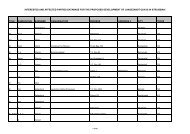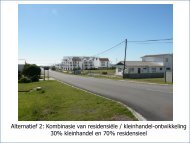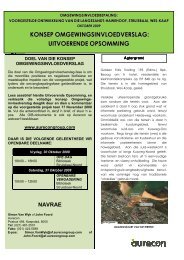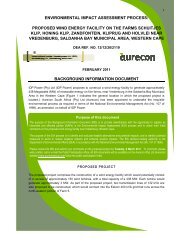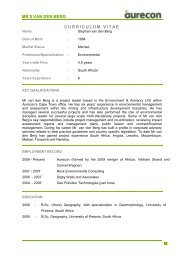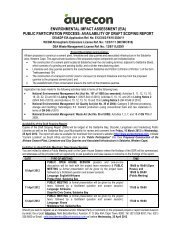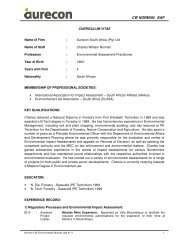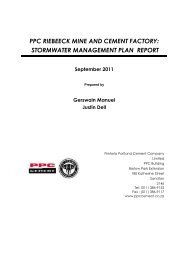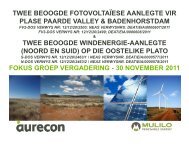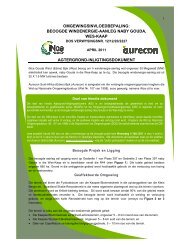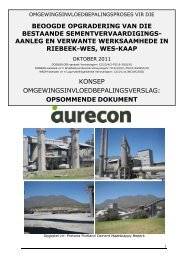Final EIAR - Aurecon AME Environmental | Environmental Projects
Final EIAR - Aurecon AME Environmental | Environmental Projects
Final EIAR - Aurecon AME Environmental | Environmental Projects
You also want an ePaper? Increase the reach of your titles
YUMPU automatically turns print PDFs into web optimized ePapers that Google loves.
Proposed Wind and Solar (Photovoltaic) Energy Facilities on Kangnas Farm near Springbok in the Northern Cape: Draft EIR 65<br />
within a 25 km radius of the development zones. Of the 115 species, 12 are red data species,<br />
60 are endemics and four red-listed endemics occur in the broader area. Potential avifaunal<br />
impacts could arise from disturbance caused by vehicular and people traffic during construction,<br />
displacement caused from habitat loss, risk of collision with wind turbine blades and power lines<br />
and behavioural displacement (alteration of flight paths). As such Mr Doug Harebottle was<br />
appointed to undertake an avifaunal specialist study. A field survey was undertaken from 24 –<br />
28 June 2012 to inform the Avifauna Impact Assessment. The Avifauna Impact Assessment is<br />
included in Annexure F and the findings and recommendations are summarised below.<br />
a) Description of the environment<br />
The landscape is dominated by low-lying flat country (plains) and granite inselbergs (particularly<br />
towards the north-west).The proposed development areas and general surroundings are all<br />
located on privately owned farmland. The Goegap Nature Reserve lies approximately 20 km<br />
west of the study area and comprises a similar avifauna to that of the site. The inselbergs<br />
consist of ridges and rocky cliffs faces and are likely to be important sources of lift for soaring<br />
species, notably raptors and possibly bustards. The ridge slopes are well vegetated and provide<br />
habitat for species with montane affinities and the boulder-koppies provide additional habitat for<br />
cliff-nesting and foraging species. Two wetland areas have been identified within the study area<br />
namely Granite Pan and Steenbok Pan which would provide seasonal habitat for wetland<br />
associated species in the area. Eskom powerlines and pylons along the N14 and south western<br />
section of the proposed wind energy facility would provide suitable perches and nesting sites for<br />
certain species such as raptors and corvids. A total of 115 species have been recorded from<br />
SABAP1 and SABAP2 of which 12 species were seen for the first time in the area. Of the 115<br />
species, seven are red-list species, 59 endemics or near endemics and three red-listed<br />
endemics (Ludwig’s Bustard, Red Lark and Sclater’s Lark). All of the red-listed endemics are<br />
likely to breed within the study area.<br />
Although intensive searches during the site survey by Mr Harebottle no active raptor nests were<br />
found. It was however strongly suspected that a Verreaux’s Eagle (previously Black Eagle) nest<br />
on the ridge where a pair of Verreaux’s Eagle was observed in the solar focus area during the<br />
site survey. Cliff lines could possibly also hold resident breeding pairs of other raptors including<br />
Booted Eagle, Jackal Buzzard, Lanner Falcon and Rock Kestrel.<br />
A variety of raptors and large terrestrial species, particularly Ludwig’s Bustard and Karoo<br />
Korhaan, frequent the wind focus area. Southern Pale-chanting Goshawk and Jackal Buzzard<br />
were also noted using areas in and around the solar focus area. Pied Crows and Cape Crows<br />
were observed on a daily basis flying around the proposed wind focus area, usually in small<br />
groups, most likely to search for sheep carcasses.<br />
The South African Shelduck was the only waterbird that was observed. Namaqua Sandgrouse,<br />
a species restricted to the arid western parts of South Africa, was observed flying in a southeasterly<br />
direction to the Granite Pan. The birds would be using the pan as a drinking area.<br />
Sociable Weavers were observed flying short distances (


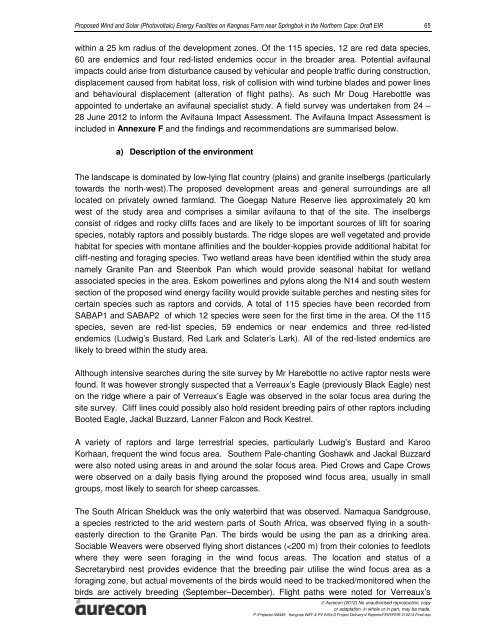
![CRR IV FEIR ~ 26042010 [FINAL].pdf - Environmental Projects](https://img.yumpu.com/21973020/1/184x260/crr-iv-feir-26042010-finalpdf-environmental-projects.jpg?quality=85)
